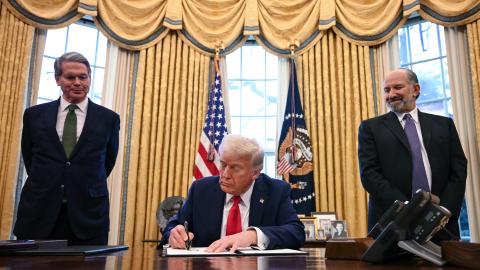As the United States seeks to strengthen its semiconductor industry—a national security imperative amid rising competition with China—the next four years will be crucial. Policymakers and industry professionals need a comprehensive strategy to build on the Trump administration’s efforts to reshore this critical supply chain.
This policy memo examines Washington’s past and present approaches to semiconductor policy and provides recommendations for the United States to secure a sustainable and successful ecosystem at a time of intensifying US-China technology competition.
1. Expand on the CHIPS and Science Act.
The CHIPS and Science Act was a historic investment in reshoring semiconductor supply chains and maintaining US leadership in the industry, and it has produced tangible successes. In 2024, Taiwan Semiconductor Manufacturing Company (TSMC) increased its total investment in Arizona to $65 billion.
Industry leaders, Congress, and the Trump administration should work together to capitalize on this momentum and develop a comprehensive plan and a concrete strategy for investing in America’s future.
The tax credits issued under the CHIPS Act have been crucial to the health of the semiconductor ecosystem and America’s success. Private investments in reshoring semiconductor production have long lifecycles that are expected to be sustained through sufficient public support. Congress should reauthorize the tax credit and expand it to include the capital-intensive research and development (R&D) process.
Public investment in chip R&D, specifically pre-competitive research, is essential and valuable. The Semiconductor Industry Association reports that for every dollar the US government invests in semiconductor R&D, the country’s gross domestic product increases by $16.50.
2. Create an attractive regulatory environment.
The United States cannot afford to drive away leading-edge innovation. US policy should balance national security and economic security concerns with the requirements for securing high-tech investment in America. In doing so, Washington can maintain a healthy semiconductor ecosystem and ensure that key components of this critical supply chain remain within US borders.
In March, TSMC committed an additional $100 billion to its operations in the United States to support “its customers, including America’s leading AI and technology innovation companies such as Apple, NVIDIA, AMD, Broadcom, and Qualcomm.” This move aligned with the Trump administration’s effort to build a comprehensive domestic semiconductor ecosystem.
There are three key regulatory issues the administration should address to attract more investment of this kind.
First, export controls and tariffs should be clearly defined and communicated. This is especially important for semiconductor firms seeking to compete globally while complying with US laws. Policymakers should continue to collaborate with industry leaders to ensure that export controls and tariffs do not hinder the high-tech sector’s ability to innovate in America.
Second, the administration should scale back the environmental permitting regulations that are slowing down efforts to reshore manufacturing. Although TSMC announced plans to build a third US fabrication facility in Arizona in April 2024, it has yet to break ground because it has not received an air permit from the Environmental Protection Agency.
Finally, protecting intellectual property remains crucial for the industry’s capacity to produce leading-edge technologies, such as ASML’s extreme ultraviolet lithography machines.
3. Close the talent deficit.
The US semiconductor industry has grown exponentially over the last two decades. But America’s workforce growth has not kept up. According to the Information Technology and Innovation Foundation, the number of electrical engineering bachelor’s and master’s degrees awarded to US citizens grew only 18.2 percent from 1997 to 2020. Meanwhile, the industry has grown by over 350 percent since 2003.
Along with ensuring more professionals pursue advanced degrees in engineering, the US needs to encourage citizens to become skilled technicians and line workers who can fine-tune their crafts to meet the industry’s standards. By reaching untapped populations and encouraging those with transferrable skills to enter the industry, the United States can empower its workforce to develop and deploy critical technologies essential to US economic and national security.
Washington can also look to its allies for help in addressing the talent shortage. The Upwards Program—sponsored by Micron and Tokyo Electron—is a partnership between US and Japanese universities that trains thousands of students on semiconductor fundamentals.
The United States can also replicate other successful talent training programs. Taiwan’s National Semiconductor Institute is a consortium of six universities focused on cultivating semiconductor talent. In 2022, they admitted a combined 483 master’s students and 80 doctoral students.
A Taiwanese Ministry of Education official highlighted an important feature of the National Semiconductor Institute: it is jointly funded by industry, government, and academia. The proportion of industry investment should be higher than that of the government. When companies decide to invest, the government will follow up and inject funds into the universities’ semiconductor programs.
4. Improve energy efficiency.
The US semiconductor ecosystem relies on strong energy infrastructure. As the industry seeks to make its equipment and products more energy efficient, the demand for chips, data centers, and AI-driven technology will also continue to increase energy demand exponentially.
Congress and the administration will need to explore policies and initiatives to incentivize the development of technologies capable of meeting the industry’s future energy demands.
5. Adopt a forward-looking approach.
These policy recommendations require Congress and the administration to adopt a forward-looking approach to semiconductor policies and regulations. Sustained US leadership in the industry requires R&D investment, close cooperation with allies, responsible regulation, and a well-trained workforce. Many of these policies may not bear fruit for years to come.
Policymakers should continue collaborating with industry leaders to determine how America can enhance national and economic security today without compromising its leadership in the global semiconductor ecosystem.
The question that should be asked about every policy is, Will it make innovation more or less likely to happen in the United States? Building a sustainable and successful ecosystem in the US that balances private and public interests will be the primary challenge moving forward.


















